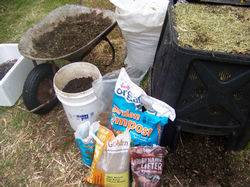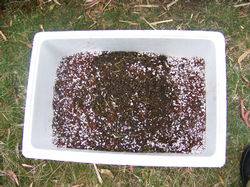My rows are piles in a row. I fluff them sideways with the front end loader, rolling the row over a little sideways. That material is wood chips and leaves that a commercial dude is delivering, just so he has a place to dump. I only take hardwood tops (leaves and branches). Horse place nearby has the poop from the stalls, but they treated their pasture with "graze on", which is edilbe Round-Up, and the poison passed through the horses into their poop. No bueno. I am not gonna go pick up cow paddies off the ground from the nearby rancher, even if he would let me. I can get plenty of chicken scat though, so that may have to be the N source. Local farmer brings in in by the big truck. Air is 80% Nitrogen. How do I get it into the compost?
The tree dude lives down the street and has big old tree top chip piles that have decomposed into dirt. There is some pine in there though. Do I want to go get that stuff?
The tree dude lives down the street and has big old tree top chip piles that have decomposed into dirt. There is some pine in there though. Do I want to go get that stuff?








